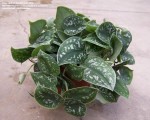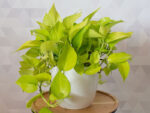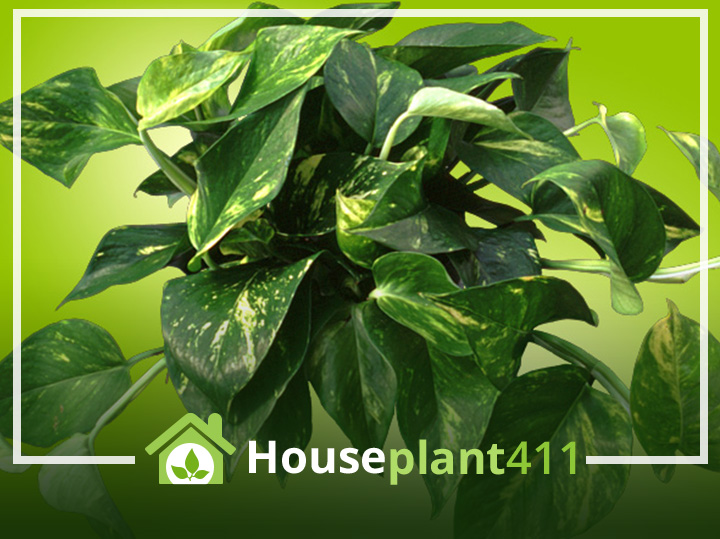About
An “Epipremnum aureum“, or a Pothos plant as we know it, was originally found in the jungles of Malaysia, China, Australia, and islands in the Pacific and Indian Oceans. Since the light at the floor of a dense, tropical jungle is often not very bright, pothos plants used the aerial roots on their long vines to cling to the trunks of trees and grow upwards towards the sunlight. Pothos plants are sometimes referred to as “Devil’s Ivy” because it is a very forgiving plant that quickly recovers and starts growing again even after suffering from poor care and poor growing conditions.
Pothos Plant Description
A pothos plant is a highly adaptable, glossy-leafed plant with leathery, pointed, heart-shaped leaves. When growing outdoors, the leaves of a pothos plant can be as large as 10”-12” (25cm-30cm). Indoors, the leaves are much smaller, usually ranging in size from 4”-6” (10cm-15cm). The solid green pothos is often confused with a heart-leaf philodendron. A pothos plant produces long, vines and looks wonderful in a hanging basket. You can also attach the stems to a moss or styrofoam pole and have a tall, upright plant.
Pothos Plant Varieties
The leaves of this hardy plant come in several colors and leaf patterns.
Golden Pothos plant has yellow and green leaves.
Marble Queen Pothos has white and green leaves.
Jade Pothos has solid green leaves.
Neon Pothos has bright green neon-colored leaves
n’joy Pothos has green leaves with a cream and yellow variegation.
Satin Pothos has dark green leaves with silver markings




Satin Pothos Neon Pothos n’Joy Pothos Marble Queen Pothos
Quick Care Tips
Minimum temperature 55°F (12.8°C)
Select the right variety for the lighting in your home
Easily propagated from stem cutting in the spring
Allow the tip 50% of the soil to dry out before watering
Conclusion
Pothos are easy to care for and a perfect plant for people just starting to grow indoor houseplants (as long they are careful not to over water). Best of all, there is a pothos plant variety for almost any location in your home or business. These plants are poisonous and are toxic to dogs, cats, and children. Please keep the long vines out of reach. Read more about common houseplants that are poisonous in Don’t Feed Me to Your Cat: A Guide to Poisonous Houseplant.
Plant Care
Light
How much light for a pothos plant: A Green Jade pothos with solid green leaves does well in low light. A Golden Pothos with yellow and green patterned leaves likes medium light. The Marble Queen pothos with green and white variegated leaves grows best in medium to bright indirect light. The lighter the colors in the leaves of a pothos plant, the more light the plant requires.
Water
How to water a Pothos plant: Water well and then allow the top 50% of the soil to dry out before watering again. Over-watering is the main reason a pothos plant dies. Bright yellow leaves indicate that the soil has dried out a bit too much before you watered it. Leaves turn pale yellow and get black marks when a pothos plant is over- watered. Over watering a pothos plant also causes new growth to turn black.
Fertilizer
How to fertilize a Pothos plant: Feed every two weeks in the spring and summer when the plant is actively growing and monthly in the fall and winter. Use a well-balanced plant food diluted to ½ the recommended strength.
Temperature
Best temperature for a Pothos plant: grows well in temperatures between 55°F – 80°F (12.8°C – 26.7°C). If temperatures drop below 45°F (7.2°C), a pothos plant stops growing and the leaves turn black.
Humidity
Basic household humidity is all a Pothos plant requires
Pests
Pothos plant pests: One of the great things about a Pothos plant is that it is rarely bothered by plant pests. However, if the soil stays too wet and is not allowed to partially dry out, fungus gnats may appear. Mealy bugs are another pest that can sometimes be a problem.
Diseases
Pothos plant diseases: Over-watering can causes plant diseases such as crown, leaf, and root rot. Once the roots are damaged, it is difficult to save a pothos plant.
Soil
Best soil for a Pothos plant: Use a well-aerated, quick-draining potting soil that dries out quickly. This type of soil prevents the roots from staying wet too long and eventually dying.
Pot Size
A Pothos likes to be root-bound in a small pot. Do not rush to move the plant to a larger pot, wait until the roots have filled the existing container. The new pot should be only one size larger than the current pot and have drip holes in the bottom.
Pruning
How to prune a Pothos plant: Aggressively prune the long vines to keep the plant looking bushy and full. 5”- 6” pothos stem cuttings can be rooted in water or vermiculite and used to propagate new plants.
Propagation
How to propagate a pothos plant: Take stem tip cuttings in the spring and summer. Read complete care instructions on how to propagate a Pothos plant using stem cuttings in the Glossary of the website.
Clean Air Plant
NASA lists a Pothos plant as a “Clean Air Plant” that helps remove harmful chemicals such as formaldehyde from the air.
Poisonous Plant Info
Pothos plants are poisonous plants with a level #2 toxicity, and is toxic to dogs, cats, and small children.
FAQ
A pothos plant gets yellow leaves a few days after you water it when you allow the soil to get too dry before watering. Water well, until the water comes out the bottom drip holes. Don’t water again until the top 50% of the soil dries out or the leaves start to droop a little. You can save an under-watered pothos plant, but an over-watered pothos can quickly die.
A pothos plant develops brown, mushy stems and new growth turns black when your pothos plant is over-watered. Cut off the dead stems and don’t water your pothos plant again until the soil has totally dried out; this gives new roots a chance to develop. You can also carefully take the pothos plant out its pot and get rid of the wet soil. Allow the plant to sit out bare root overnight and replant in new, fresh, dry soil.
You need to aggressively prune a pothos plant to help it get it full again. By cutting several inches off of each of the long runners, you’ll encourage new growth to develop all along the stem. You can use the Stem Cuttings to propagate a new pothos plant.
Pothos plant leaves turn black when the air in the room is too cold (below 55° for a long period of time). Cut the damaged leaves off your pothos plant; trim back the stems, and move your plant to a warmer location. The roots are fine and your pothos plant should grow back in no time.

